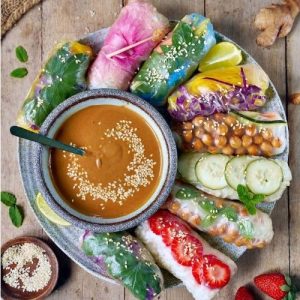
Vegan Summer Rolls
These vegan summer rolls are light, colorful, and packed with fresh vegetables, protein-rich chickpeas, and healthy fats. Perfect for a quick meal, appetizer, or meal prep, they’re easy to assemble and pair beautifully with peanut or hoisin dipping sauce. Gluten-free, low in saturated fat, and fully plant-based, they’re a nutritious treat for any time of day.
Equipment
- Large bowl or pot (for soaking rice paper)
- Kitchen towel (damp, for rolling)
- Spiralizer or knife (for vegetables)
- Saucepan (optional, for chickpeas)
- Colander (for noodles)
Ingredients
Rice Paper
- 7 –10 sheets rice paper
Vegetables & Fillings
- ½ avocado sliced
- ¼ cup green bell pepper thinly sliced
- ¼ cup red bell pepper thinly sliced
- ¼ cup yellow bell pepper thinly sliced
- 1 zucchini spiralized or finely sliced
- 1 carrot spiralized or finely sliced
- 1 cucumber spiralized or finely sliced
- ½ cup red cabbage shredded
- ½ can chickpeas optional (crispened in oil and soy sauce)
- Lettuce leaves fresh herbs (mint), fruits, and edible flowers, optional
Noodles
- 120 g cellophane noodles or thin rice noodles
Instructions
- Prepare the Noodles: Begin by cooking your cellophane or thin rice noodles according to the package instructions. You can either briefly boil them for a few seconds or soak them in hot water until soft, depending on the brand. Once softened, drain the noodles in a colander and rinse under cool water to stop the cooking process. This will keep them from sticking together. If you’d like, you can divide the noodles into portions and add natural color—use beet juice for pink, turmeric for yellow, or blue spirulina powder for a vibrant blue hue. Set aside to cool completely while you prepare your vegetables.
- Chop, Slice, and Spiralize the Vegetables: Next, focus on the fresh fillings. Wash all your vegetables thoroughly. Slice the avocado into thin, even pieces. Cut the bell peppers into thin strips, one color at a time for a visually appealing roll. Spiralize the zucchini, carrot, and cucumber into fine ribbons or slices. Shred the red cabbage into small, delicate strips. Lay all vegetables in separate bowls or on a tray to make assembling your rolls quick and organized. This step ensures every roll will have a consistent and colorful presentation.
- Optional: Crisp the Chickpeas: If you are adding chickpeas, heat a small amount of oil in a saucepan over medium heat. Add the drained chickpeas and a splash of soy sauce or tamari. Sauté for a few minutes until they become slightly crisp on the outside but remain tender inside. This step enhances the texture and flavor, making the rolls more satisfying. Once cooked, set them aside to cool slightly.
- Prepare Your Rolling Station: Lay a clean kitchen towel flat on your counter. Dampen it slightly—this will prevent the delicate rice paper from sticking while you roll. Fill a large bowl or shallow pot with warm water for dipping the rice paper. Make sure the water is deep enough to fully submerge each sheet. Having everything ready at your rolling station will make the assembly process smooth and stress-free.
- Soak the Rice Paper: Take one rice paper sheet and briefly dip it into the warm water for 2–3 seconds. Do not soak too long, or it will become too soft and tear easily. Lift it carefully, allowing excess water to drip off, and place it flat onto your damp kitchen towel. The rice paper should be pliable but still slightly firm to handle.
- Assemble the Filling: Place your noodles about 1/3 of the way from the bottom of the rice paper. Arrange the spiralized vegetables, shredded cabbage, bell peppers, avocado, chickpeas, and any optional herbs or flowers on top of the noodles. Be careful not to overfill, leaving about 1–2 inches of space on each side for folding. Remember, the ingredients placed at the bottom will become visible on top when rolled, so arrange them thoughtfully for a beautiful final appearance.
- Fold and Roll the Summer Rolls: Begin by folding the left and right sides of the rice paper over the filling. Next, starting from the bottom, carefully roll the paper upwards, tucking the filling inside as you go. Apply gentle, even pressure to avoid tearing. If a tear occurs, you can use a second rice paper to wrap over the broken roll. Repeat this process with the remaining sheets and fillings, working one at a time to ensure all rolls are uniform and intact.
- Serve with Sauce: Once all rolls are assembled, arrange them neatly on a serving platter. Pair with a creamy peanut sauce, hoisin sauce, or your favorite dipping sauce. For extra flavor, sprinkle chopped peanuts, sesame seeds, or fresh herbs on top. Serve immediately, or cover with a slightly damp cloth and refrigerate for up to a few hours if preparing ahead.
- Storage Tips (Optional Step for Meal Prep): If making in advance, store the rolls in an airtight container lined with a damp paper towel to prevent drying out. Avoid stacking them tightly to maintain their shape. They can last in the refrigerator for up to 24 hours. For best results, dip them in the sauce just before serving to keep the rice paper crisp and fresh.
Notes
- Prepare all fillings before soaking the rice paper to make rolling easier and faster.
- Do not over-soak rice paper; 2–3 seconds in warm water is usually enough.
- Mix and match vegetables based on seasonality or preference for color and flavor.
- Crisping chickpeas is optional but adds texture and extra protein.
- Use a damp kitchen towel on your workspace to prevent rice paper from sticking.
- Serve immediately for best freshness; rolls can dry out if left uncovered.
- Optional natural coloring for noodles adds visual appeal, especially for kids or special occasions.